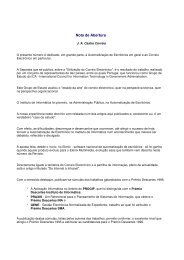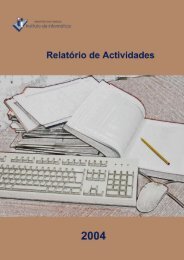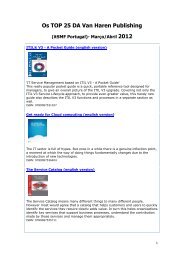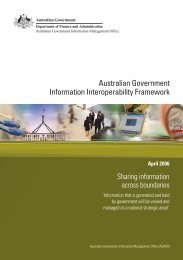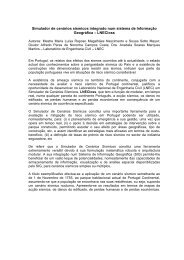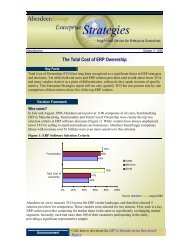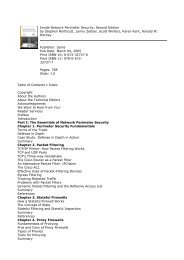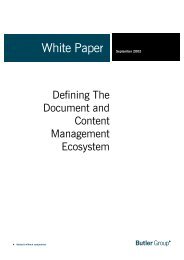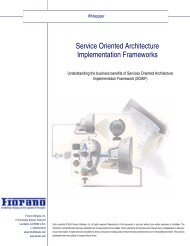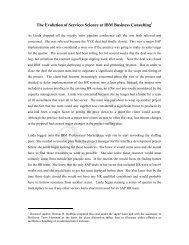OECD Peer Review of E-Government in Denmark - ePractice.eu
OECD Peer Review of E-Government in Denmark - ePractice.eu
OECD Peer Review of E-Government in Denmark - ePractice.eu
You also want an ePaper? Increase the reach of your titles
YUMPU automatically turns print PDFs into web optimized ePapers that Google loves.
Figure 7.8 Use <strong>of</strong> electronic delivery channels<br />
100<br />
90<br />
80<br />
70<br />
60<br />
%<br />
50<br />
40<br />
30<br />
20<br />
10<br />
0<br />
Websites Portals Voice services SMS WAP MMS<br />
Yes<br />
Source: <strong>OECD</strong> E-<strong>Government</strong> Survey: <strong>Denmark</strong>.<br />
The large difference <strong>in</strong> the level <strong>of</strong> service delivery through organisation-level Web sites versus<br />
portals <strong>in</strong>dicates a significant opportunity for <strong>Denmark</strong> to <strong>in</strong>crease the level <strong>of</strong> user-focus it is already<br />
achiev<strong>in</strong>g. The number <strong>of</strong> Web sites <strong>in</strong> the Danish public sector is large and grow<strong>in</strong>g, with more than<br />
2,000 now <strong>in</strong> service, none <strong>of</strong> which are subject to any formal or mandatory design guidel<strong>in</strong>es<br />
(someth<strong>in</strong>g recommended <strong>in</strong> the MVTU study <strong>of</strong> study <strong>of</strong> citizens’ e-government experiences). In<br />
their absence, there is potential to present users with a bewilder<strong>in</strong>g and <strong>in</strong>consistent array <strong>of</strong> options<br />
for access<strong>in</strong>g e-government, and also to fail to achieve the most efficient and effective use <strong>of</strong> the<br />
Internet as a delivery channel.<br />
Portals are potentially a much more user-focused way <strong>of</strong> deliver<strong>in</strong>g onl<strong>in</strong>e <strong>in</strong>formation and<br />
services than <strong>in</strong>dividual Web sites. Currently, most <strong>OECD</strong> government portals can be described as<br />
first-generation sites that aggregate the Web-based <strong>in</strong>formation and services <strong>of</strong> <strong>in</strong>dividual<br />
organisations <strong>in</strong>to a more coherent and conveniently accessed bundle <strong>of</strong> e-government <strong>of</strong>fer<strong>in</strong>gs.<br />
Future generations <strong>of</strong> portal development are expected to <strong>in</strong>creas<strong>in</strong>gly enable <strong>in</strong>tegration and<br />
customisation/personalisation <strong>of</strong> services <strong>in</strong>to even more user-focused <strong>of</strong>fer<strong>in</strong>gs.<br />
Danish organisations make significant use <strong>of</strong> a wide range <strong>of</strong> portals for deliver<strong>in</strong>g e-government<br />
(see Figure 7.8). As noted <strong>in</strong> Chapter 6, activity related to portals is a significant aspect <strong>of</strong><br />
e-government collaboration, with 51% <strong>of</strong> <strong>OECD</strong> survey respondents report<strong>in</strong>g that they were actively<br />
work<strong>in</strong>g together to establish portals.<br />
In look<strong>in</strong>g more closely at how portals are be<strong>in</strong>g used, the survey treated delivery <strong>of</strong> <strong>in</strong>formation<br />
and delivery <strong>of</strong> services separately. In terms <strong>of</strong> <strong>in</strong>formation delivery, the most widely used portal is the<br />
all-<strong>of</strong>-government www.danmark.dk, which is designed to provide a convenient way <strong>of</strong> guid<strong>in</strong>g users<br />
towards the Web sites <strong>of</strong> government organisations. Given its function, it is <strong>in</strong>terest<strong>in</strong>g to note that not<br />
all organisations surveyed provided <strong>in</strong>formation through this portal. Sector portals are the second most<br />
widely used portals for <strong>in</strong>formation delivery, followed by specific user-group portals, and f<strong>in</strong>ally the<br />
bus<strong>in</strong>ess portal www.virk.dk.<br />
134



